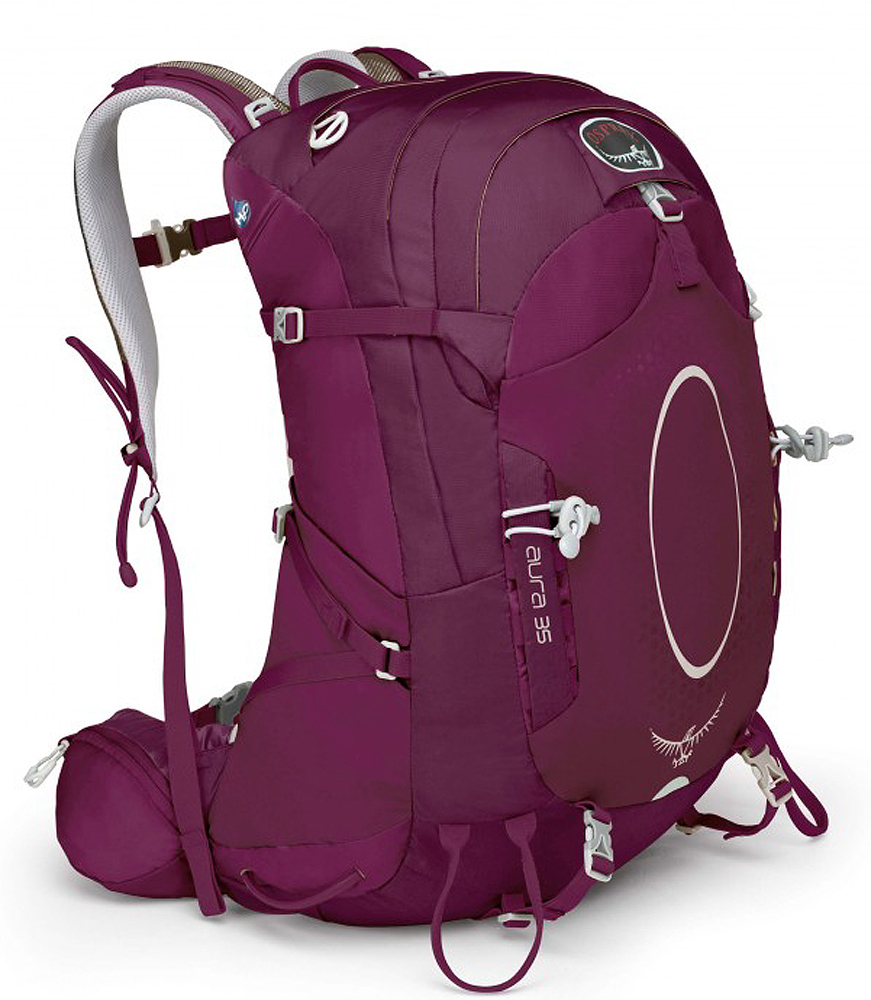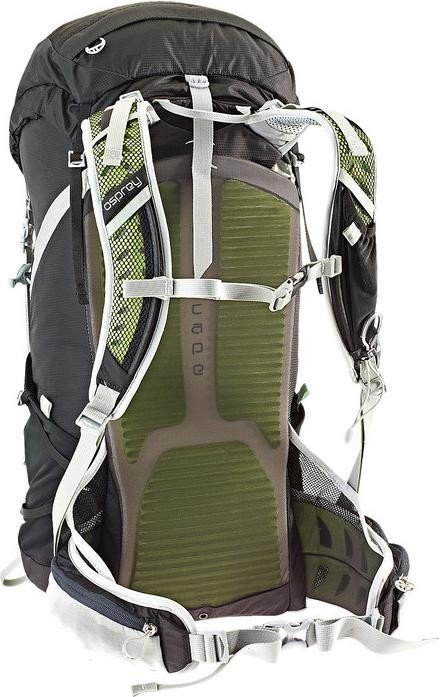
Since I started seriously planning a long walk back in 2007, my list of what (I thought) I would need to stay warm, dry and comfortable has changed a LOT. You learn by trial and error, and after quite a few walks I know better what works for me on the trails of mainly Spain. I am not claiming to know what suits others at all, but over the years I have tried, tested and discarded quite a few bits of kit, and researched and discussed the pros and cons of lots of others. Someone out there might be interested in not just the kit itself, but the reasoning behind the choices I have made, so I thought I’d make a list of the what and why of my current kit.
After reading lots about packs in the pilgrim forum, I started by narrowing my camino pack search to 30-35 litre packs with a hip belt and some sort of ventilation.
I got a Karrimor one with an air channel at the back, but the air channel didn’t channel any air, the foam on either side got soggy and cold, and the pack itself was very heavy for what it was. I decided I needed more targeted padding for it to be worth the extra weight.
So I got a Gregory which was lighter and had all the right features, including supportive padding in the lower back. That padding didn’t work for me at all, it gave me a backache, so I sold it on.
Then I got a Bergans model while I was back home in Norway, but it was too tall for me – I couldn’t look up at the sky or even ahead on a steep hill without banging my head in the frame. I needed a shorter back frame. Also I realised I wanted a pack that could go as hand luggage on flights to save money and stress.
These three failed attempts helped narrow my search: I now knew I wanted a 30-35 litre pack with hip belt, ventilation, less padding, within hand luggage size, and of course lightweight.
I found a Lowe Alpine Mountain Marathon 32, which was almost perfect. It had a stretchy stash pocket at the front and one either side, and a zip instead of a lid! But there was no ventilation and no load lifters, so it ended up weighing on my shoulders in spite of the hip belt.


I loved that big stretch pocket though, it is brilliant for quick access to that extra layer, or stashing the wet poncho, or keeping your banana from being squished … so I tried to love the Lowe Alpine Eclipse 32, which had all the same features plus the ventilation, but the shoulder straps were simply too close together and rubbed at my neck. Very disappointing.
But when I discovered the similar Osprey Talon, I fell swiftly and passionately in love. I got the unisex 44L version, with a bottom zip for easy access, drawstring top, big roomy lid, stretchy stash pocket and compression straps in all the right places. Only one fly in my ointment – it has stiff stays that transfers the weight to the hips, but those stays dig into my duck bum (your backside shape may vary).
So after a short and sweet dalliance I ended up swapping it for the then brand new Aura 35L model (similar to the new Mira) with trampoline ventilation back and panel (zip) opening for my 2012 Camino Francés. It even had side compression straps that could be threaded inside or outside the stretch side pockets! That meant I could thread the strap inside the stretch pocket on the side where I kept my water bottle, for easy access, and outside on the side I kept my snacks, to keep them in place. Brilliant! I loved it dearly for years, but it developed a nasty squeak in the stiff frame and got replaced under Osprey’s All Mighty Guarantee (a selling point in itself). Sadly the replacement squeaked too, and in the end I asked for my beloved and by then discontinued Aura to be replaced with a different – frameless and silent – model.




Enter Talon 44’s younger sibling, the Talon 33 without the stays and the bottom zip, but with the inside/out compression straps on the side and a ventilated ridged mesh covered back panel which moulds really well to my/any shape. By now they even had a bungee system for quickly stashing and carrying your poles! For our honeymoon camino my Scouse Spouse took the Talon, and I invested in the then brand new women’s version, the Tempest 30. As long as you pack light, you can’t go far wrong with these models, in my opinion, as they have so many adjustments to create a custom fit. They can even fit under the Ryanair seat in front of you. Look:

The Talon/Tempest models have another fabulous advantage: They fit in the washing machine! So machinewashability was added to the list of desirable traits. They also made me realise I prefer a ventilated harness, rather than a thickly padded one that just goes hot and damp. The one thing I miss on the Talon/Tempests are the top compression straps, which are perfect for hanging sandals or wet towels or just cinching the load down and stabilising it. So when I started longing for an Aura style panel opening pack with top compression straps again, I looked first at more Ospreys – and not just the hiking ones.


And lo and behold, I found the aptly named Escapist 25 litre biking pack with (that list again:) hipbelt, ventilation, no lumbar pad, hand luggage size, stash pocket, load lifters, inside/out side compression straps, top compression straps, machinewashability and ventilated harness, as well as being lightweight and panel loading. It even has a built-in rain cover and a zipped bottom opening so I can get my sleeping bag out straight away, and a zip-in divider to separate wet or dirty shoes or clothes from the rest. It’s basically very hard to beat! The only thing that’s missing is the Osprey Stow on the Go pole carrying system, now that I am using Pacerpoles on my walks, but I just clip them into the sternum and waist belt when I am not using them, which isn’t often. (And I have just realised how much the Escapist resembles my first backpack love, the MM32 …)
But then – screech! Spanner in the works! Along came brexit and ruined my perfect set-up. One of the reasons I can manage with such a small pack, is that I ship my Pacerpoles to my first accommodation in advance so I can take the pack into the cabin. I have been willing to forego taking extra liquids etc for the benefit of never letting the pack out of my sight, as the postal service there and back is quick, cheap and easy. But no more. When I sent them to Burgos, it took 3.5 weeks instead of one, and when the postman finally came, he delivered a card and not my poles – I had to go to Burgos main post office to collect them and pay the same amount again for the privilege – both ways! All part of being outside the customs union, so thanks for that, brexit voters. Now what pack could I fit the poles in? The Talon 33, but only just, and definitely not the Escapist. Big sigh. I suppose I could check in a smaller bag with just the poles and a knife but it seems like such a waste of a check-in fee … and what would I ship them in, would I carry that with me? When I noticed the max hand luggage size had shrunk as well, I was back to the drawing board.
With the help of other panel loader lovers on the pilgrim forum, I found the Gregory Juno 30. Well, if I am paying to check it in, I might as well pick one with a rigid frame – I have always wanted to see how much of a difference a ventilated back would make on a hot day. Also I can fit the dismantled poles and a camino kit in there, but no more. It has everything mentioned above apart from machinewashability, and the ventilated trampoline mesh back really does make a difference!


Basically, after ten years and near enough 5,000 km of backpack carrying, I now have a pack for every occasion, hot or cold, big or small. I still have a wandering eye for packs, but I can’t seem to beat the ones I’ve got, because I have picked them for their features and fit, not fickle fads. I have a pack for long winter or Norwegian walks, for lightweight camino hikes and for local strolls, and I love them all.
No matter how much you ponder and list the features you want and don’t want in a pack though, nothing beats trying them on, with weight in, and moving about with them for a period of time. Ideally longer than you can in a shop unless you stay all day. That said, a good outdoor shop should help you load it up with beanbags or weights and help you adjust it to fit you. And make sure you try some that are not on your list too, you might surprise yourself!
Rule of thumb is to try before you buy, definitely, and if you try it and it is perfect, but it’s too expensive, start trawling the online shops, try Ebay or hang on for the sales. Also check out the return policy before you pay – can you take it home, carefully pack it with blankets and tins of tomato soup, and walk around the house and up and down the stairs with it all day? Can you still return it for a refund if it’s not right for you? Have you got your other kit ready to do a trial packing and see if the pack will be big/small enough, with easy access to snacks, water, or rain gear? And please, please, make sure you try out all the straps and adjustments and learn what they do. I have adjusted lots of ill-fitting packs on the road and I like it, but just in case I’m not nearby – make sure you know your own pack. Over time straps will need a tug, weight will shift and need stabilising … just learn how to use it. If you find yourself queueing for a bed/café con leche/beer and you’ve forgotten to take your pack off, you know you have found the right one! Best of luck in your search.
Thanks for reading all of that, hope it helps figuring out what features you think you might like, or want to avoid, or maybe hadn’t thought of. And if you’ve found a pack with some wonderful feature I haven’t mentioned, please let me know!